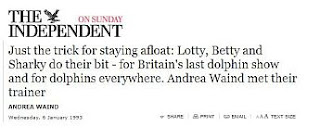 |
BACKGROUND
Flamingo Park opened on 28th June 1961 by Pentland Hick as The Yorkshire
Zoological Gardens. In 1963, it was the first to display cetaceans in
the UK, followed closely by Marineland Morecambe. The original dolphin
pool was a small figure of eight facility in the reptile house. As well
as bottlenosed dolphins, other whales were imported, including a young
white whale in 1964 and a young pilot whale in 1966. In 1965, Hick
decided to float the zoo on the UK Stock Exchange, and it became
Associated Pleasure Parks.
The success for the pioneering dolphin exhibits was due to the insight of the zoo professional Reg Bloom, who later was involved in similar developments at Windsor Safari Park, London Dolphinarium and Clacton Pier.
See The Flamingo Park Story 1965
In 1967, a larger facility was constructed that, over several years, then housed bottlenose dolphins and the male killer whale 'Cuddles', who arrived in November 1968. The park also now owned and operated a zoo and Marineland at Cleethorpes, which opened in 1966, and for a period owned Dudley Zoo, which displayed dolphins and also housed 'Cuddles', who was moved there from Flamingo Park in May 1971. The park was now owned by Scotia Pleasure Parks, a division of Scotia Leisure whose board of directors included Don Robinson, who was also the owner of the Scarborough Marineland and Zoo.
See Flamingoland Guide Book 1971
From 1975 until early 1977, the dolphinarium, which had been rebranded Ocean World, was operated, and the dolphins supplied by Jervale Ltd a company owned by filtration engineer John Nolan and his wife. Jervale also operated a dolphin holding facility in South Elmsall for a short period in 1974 and supplied animals for Ocean Park in Seaburn, Sunderland. In 1975, two of their dolphins were involved in a dolphin show in Taiwan for three months, returning to the Flamingo Park in July that year and for a three week Christmas show at Sheffield Road Baths in Rotherham. They also supplied a sea lion show in the summer of 1975 at the now disused dolphinarium at Porthcawl. In May 1976, Nolan's transported a dolphin to Yorkshire Television Studios in Leeds which was displayed, a portable tank for the popular science program "Don't Ask Me". The animal safely returned to Flamingo Park the next day.
After this time, the operators of Margate Dolphinarium were involved in supplying one or more dolphins for one summer season in 1979.
In 1978, the park was bought by a former director of Scotia Leisure, Robert Gibb, whose family continue to run the park today. From 1979 and until 1984, the facility remained empty and did not display animals.
The last three dolphins arrived in 1984 - at the now renamed Flamingoland - and were owned and cared for by Dolphin Services UK. The animals remained on site until 1993 when the dolphinarium finally closed due to new husbandry legislation for UK cetaceans; the pool failed to remain legal due to it not being deep enough.
The three female dolphins were then successfully relocated to European collections and have since successfully bred and reared several calves.
Lotty's first calf was Lyra (F), born in 1990. Her second calf was Lotus (M), born in 1995. Lyra still resides in Kolmården. Lotus now resides at Zoomarine, Portugal.
Betty gave birth to Nau (F) in 2001; Tango (M) in 2005; Mia (F) in 2008. Tango sadly died in 2008. However, Nau successfully gave birth in 2014 to Goccia (F). Betty, Nau and Goccia reside at the Acquario di Genova. Mia resides in Oltremare, Riccione, Italy.
Sharky gave birth to Jo (F) in 2011. These two animals reside at Marineland in Antibe.
Sharky and Betty remain alive. Lotty died in February 2020 at Marineland in Antibe
A Review of Dolphinaria states:
Pool: 'Figure of eight' shaped main pool; 24.38 m max. length, 2 x 12.19 m diameter, 3/4 pool 4.27 m deep, rest 2.74 m, surface area approx. 233 m2 . Rectangular holding pool adjoining; 6.40 x 7.62 x 3.05 m deep, surface area 48.77 m2 , which can be operated separately. Total surface area approx. 282 m2. Partly indoor, salt mix water.
PHOTOGRAPHS

Underwater photography displayed is from Ian Valentine taken mid-1980's
VIDEO
RESEARCH
Bloom, P. R. S., Goodson, A. D., Klinowska, M., & Sturtivant, C. R. The activities of a wild, solitary bottlenose dolphin (Tursiops truncatus). Aquatic Mammals, Volume 21(1), 19-42
https://new.aquaticmammalsjournal.org/wp-content/uploads/2009/12/21-01_Bloom.pdf
Bloom, P.. The diary of a wild, solitary, Bottlenose Dolphin (Tursiops truncatus), resident off Amble on the north Notherumberland coast of England, from April 1987 to January 1991. Aquatic Mammals, Volume 17(3), 103-119
https://new.aquaticmammalsjournal.org/wp-content/uploads/2009/12/21-01_Bloom.pdf
These were the last dolphins to be displayed at the park and they moved to European facilities when the dolphinarium closed in 1993.











































































































